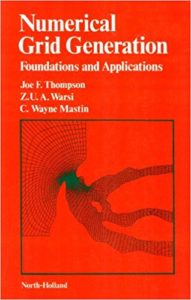Numerical Grid Generation Foundations and Applications 1st Edition
Numerical Grid Generation Foundations and Applications 1st Edition
Numerical Grid Generation Foundations and Applications 1st Edition has now become a fairly common tool for use in the numerical solution of partial differential equations on arbitrarily shaped regions. This is especially true in computational fluid dynamics, from whence has come much of the impetus for the development of this technique, but the procedures are equally applicable to all physical problems that involve field solutions.
Numerically generated grids have provided the key to removing the problem of boundary shape from finite difference methods, and these grids also can serve for the construction of finite element meshes. With such grids all numerical algorithms, finite difference or finite element implemented on a square grid in a rectangular computational region regardless of the shape and also configuration of the physical region. (Finite volume methods are effectively a type of conservative finite difference method on these grids.)
You can also Read Using Computational Fluid Dynamics
Numerical Grid Generation Foundations and Applications 1st Edition Product details![Numerical Grid Generation]()
- Paperback: 502 pages
- Publisher: Elsevier Science Ltd; First Edition edition (May 1985)
- Language: English
- ISBN-10: 044400985X
- ISBN-13: 978-0444009852
- Package Dimensions: 8.9 x 5.8 x 1.1 inches
- Shipping Weight: 1.5 pounds
In Numerical Grid Generation Foundations and Applications 1st Edition, grid generation and the use thereof in numerical solutions of partial equations discussed. The intent was to provide the necessary basic information, from both the standpoint of mathematical background and from that of coding implementation, for numerical solutions of partial differential equations constructed on general regions.
Since these numerical solutions ultimately constructed on a square grid in a rectangular computational region, any solution algorithm that can treat equations with variable coefficients is basically applicable, and therefore discussion of specific algorithms is left to classical texts on the numerical solution of partial differential equations.
Numerical grid Considered as a procedure for the orderly distribution of observers, or sampling stations, over a physical field in such a way that efficient communication among the observers is possible and also that all physical phenomena on the entire continuous field represented with sufficient accuracy by this finite collection of observations.
Download
Numerical Grid Generation Foundations and Applications 1st Edition


Comments are closed.